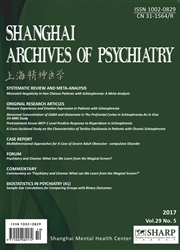

 中文摘要:
中文摘要:
背景:人类大脑是由白质(WM)束结构性互相连结的复杂网络。精神分裂症(schizophrenia,SZ)可以被概念化为以WM路径广泛断开为特征的中断综合征。目的:评估解剖性断开是否与SZ患者的大脑半球内与大脑半球间的拓扑性质破坏有关。方法:我们采集了24例处于发病急性期的偏执型精神分裂症男性患者和24例与之年龄匹配的健康男性对照组的弥散张量成像(diffusion tensor imaging)数据。本研究构建了大脑的部分各向异性加权的(fractional anisotropy-weighted,FA—weighted)结构网络,并且通过估计平均特征路径长度(characteristic path lengths,CPLs)评估大脑内半球间与半球内的整合。结果:SZ患者组的全部18个所评估的半球间与半球内的CPL值均值均长于对照组,但这些差异中只有一些具有显著性,包括:整体半球间、左半球内部和右半球内部网络的CPL;额叶、颞叶和皮质下结构的半球间子网络的CPL;以及右半球内额叶子网络的CPL。在24例患者中,双侧额叶子网络间的CPL与阴性症状严重程度正相关,但这是72个相关性分析中唯一显著的结果,所以它可能只有统计学上的显著意义。结论:我们的研究结果表明,男性偏执型SZ患者的脑半球内和半球间白质束的完整性被破坏,这支持了精神分裂症的大脑网络中断模型(即“连通性假说”)。我们需要对更特异的精神分裂症患者样本进行更大规模的研究来证实这些结果。
 英文摘要:
英文摘要:
Background: The human brain is a complex network of regions that are structurally interconnected by white matter (WM) tracts. Schizophrenia (SZ) can be conceptualized as a disconnection syndrome characterized by widespread disconnections in WM pathways. Aims: To assess whether or not anatomical disconnections are associated with disruption of the topological properties of inter- and intra-hemispheric networks in SZ. Methods: We acquired the diffusion tensor imaging data from 24 male patients with paranoid SZ during an acute phase of their illness and from 24 healthy age-matched male controls. The brain FA-weighted (fractional anisotropy-weighted) structural networks were constructed and the inter- and intra-hemispheric integration was assessed by estimating the average characteristic path lengths (CPLs) between and within the left and right hemisphere networks. Results: The mean CPLs for all 18 inter- and intra-hemispheric CPLs assessed were longer in the SZ patient group than in the control group, but only some of these differences were significantly different: the CPLs for the overall inter-hemispheric and the left and right intra-hemispheric networks; the CPLs for the inter- hemisphere subnetworks of the frontal lobes, temporal lobes, and subcortical structures; and the CPL for the intra- frontal subnetwork in the right hemisphere. Among the 24 patients, the CPL of the inter-frontal subnetwork was positively associated with negative symptom severity, but this was the only significant result among 72 assessed correlations, so it may be a statistical artifact. Conclusions: Our findings suggest that the integrity of intra- and inter-hemispheric WM tracts is disrupted in males with paranoid SZ, supporting the brain network disconnection model (i.e., the 'connectivity hypothesis') of schizophrenia. Larger studies with less narrowly defined samples of individuals with schizophrenia are needed to confirm these results.
 同期刊论文项目
同期刊论文项目
 同项目期刊论文
同项目期刊论文
 期刊信息
期刊信息
